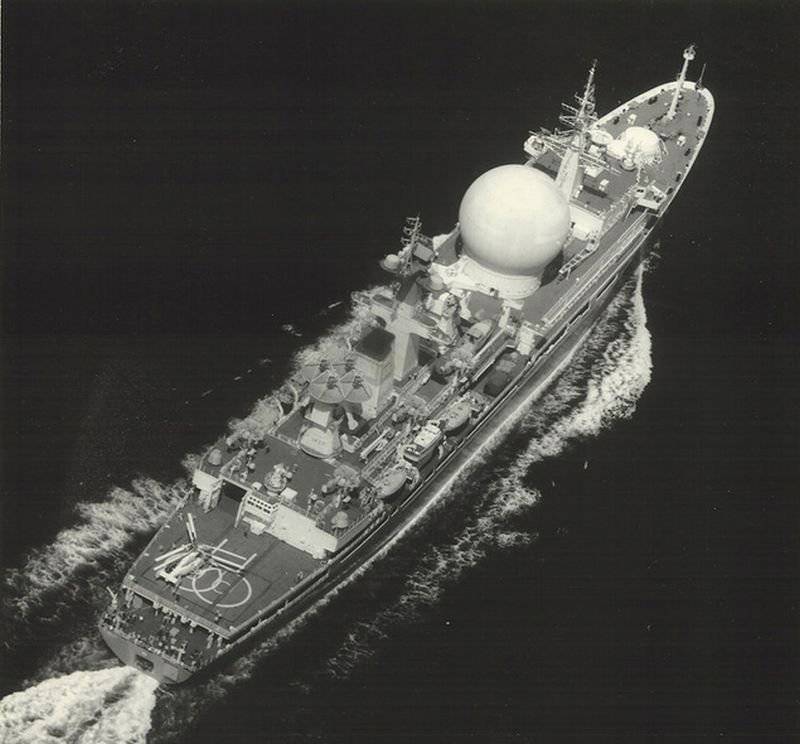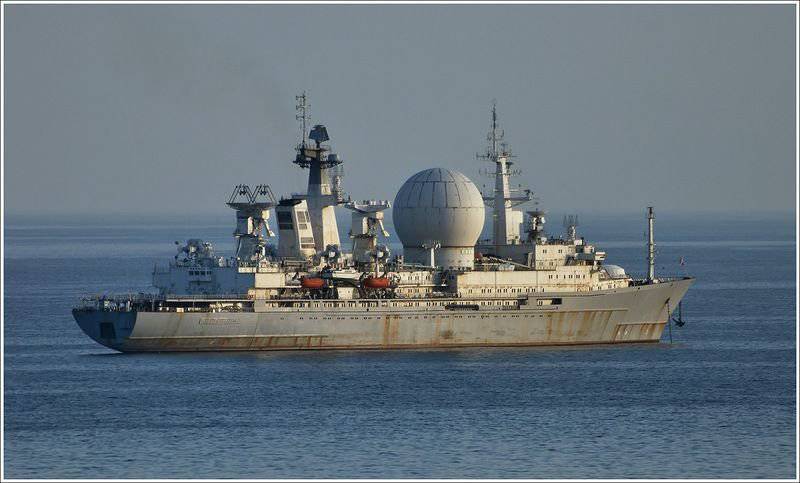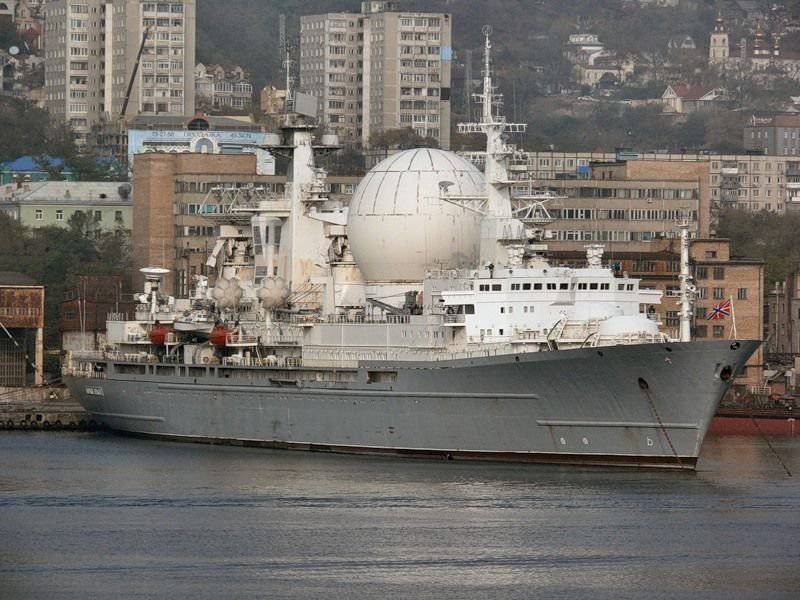The last of the test ships is the ship of the 1914.1 project, the Marshal Krylov communications vessel.

We are always happy for new developments and production of new weapons and military equipment, increasing the power of the native state. However, how little we know about who helped create and experience it. But these are thousands of people with unobtrusive occupations, hundreds of types of auxiliary equipment and equipment, whose task is only to take measurements, study the results and remnants of military equipment and weapons, bring the day when new models of weapons to defend their home country with all their might. They always stand aside, no one talks about them, but without them there was never invincible Russian armament. KIK - the ships of the measuring complex, belong just to this type of auxiliary ships that performed and perform the functions of tracking, taking measurements and data from intercontinental combat missiles, space shuttles, satellites and ships.
Creating ships KIK
The need for ships capable of carrying out various measurements of intercontinental rockets arises at the beginning of the space age. The missiles equipped with nuclear warheads reached a level when test sites became small for them - the range of the missile began to be measured thousands of kilometers. Previously, the observation and measurement of parameters was carried out measuring points installed on ground polygons. Now, when the rocket was launched could fly half the world, new means of their control and measurement were required.
The ships owe their appearance to TsNII-4 and to personally outstanding designer Sergei Pavlovich Korolev. It is with his proposal to create a naval command-and-measuring complex and push it to the open spaces of the Pacific to control the testing of strategic missile weapons. story These amazing auxiliary vessels - the history of the symbiosis of the space and sea fleets.
1958 year. The leadership of the Soviet Union decides on the creation and construction of the ship - command-measuring complex. To create a CIC attract a huge number of people of different specialties and many enterprises of the military industrial complex. The first to deliver dry-cargo project 1128, created in Poland for the Soviet Union as transport cargo ships, for re-equipment in the CIC. The design part of the CIC is the Leningrad Central Design Bureau and the Baltsudoproject. After receiving the ships, work began on equipping them with special equipment. It is worth noting that at that time there was practically no measuring equipment and equipment for using it on surface ships, and it was removed from ground stations and automobile chassis. Command and instrumentation equipment was installed in the holds of ships on special platforms. In addition to equipment and equipment, the ships received reinforced platings for the possibility of making a campaign (expedition) through the northern sea route. All the work on equipping and equipping the ships was completed by the summer of 1959, after which sea trials of the CFC immediately began.
All CICs entered the so-called “TOGE” - the Pacific Hydrographic Expedition. The base of TOGE is a bay on the Kamchatka Peninsula (later the town of Vilyuchinsk grew up there).

[/ b] The main tasks of TOGE: [/ b]
- measurement and tracking of the flight path of the ICBM;
- tracking the fall and determining the coordinates of the fall of the head of the rocket;
- control and tracking of the mechanisms of a nuclear device;
- removal, processing, transmission and control of all information from the object;
- control of the trajectory and information coming from the spacecraft;
- support for continuous communication with astronauts aboard spacecraft.
The first ships of the 1128 project - Sakhalin, Siberia, Suchan (Spassk) were combined into the first floating measuring complex (1PIK), conditional name - “Brigade S”. A little later they were joined by the ship project 1129 Chukotka. All ships are commissioned in the 1959 year. Cover legend is the Pacific Oceanographic Expedition (TOGE-4). In the same year, the ships made the first expedition to the area of the Hawaiian Islands, which became known as the Aquatoria missile testing ground. These were the first ships to sail to the center of the Pacific Ocean, whose autonomy reached 120 days.
Everything on this expedition was top secret, the mentions of these ships threatened at that time to be sent to places not so distant for the disclosure of state secrets. The ships had an unusual silhouette and color of coloring - on the ball-colored hull there were white superstructures with various antennas. The main equipment was radar stations and direction finders, hydrophones and echo sounders, telemetry stations and secret communications. And although the flags of the Navy were hung on them, the absolute majority of the population of the Soviet Union, even the commanders of military units, surface and submarine ships, did not know who they obey, where they are and what they do. The officers who came to serve on such ships only when they accepted the position learned that hydrography was only a cover for the real tasks of the ship.
The secrecy of the ships was in everything, for example, when moving from Kronstadt to the home base, all visible antennas were dismantled and put back only in Murmansk. In the same place, the ships equipped Ka-15 deck helicopters. To ensure further advance ships allocate icebreakers. On the road, helicopters worked out various tasks for lapping to the ship and reconnaissance of the ice situation. And although the helicopters were tested in the North, and the combat missions were solved at the Equator, the Ka-15 helicopters proved themselves well and for a long time remained the main helicopters of these ships.
The ships were subsequently commissioned:
- KIK-11 “Chumikan”, the ship of the project 1130, was put into operation 14 June 1963;
- KIK-11 “Chazhma”, the ship of the project 1130 was put into operation on July 27 1963;
- “Marshal Nedelin”, the ship of the 1914 project, was put into operation on December 31 1983;
- “Marshal Krylov”, the ship of the 1914.1 project, was put into operation on February 28 of the year 1990;
After joining the ships of the project 1130, created 2 PIK, code name "Brigade H". Cover legend - TOGE-5. In 1985, ships enter the KNIK 35 brigade. The brigade followed the orders of the commanders of the Navy and the Strategic Missile Forces of the Soviet Union during combat and daily life. In addition to the measurement ships, two raids of the boats and one tug MB-260 were enlisted in the brigade.
Combat operations and CIC assignments
The presence of TOGE spacecraft was a prerequisite for the start of testing of all Soviet ICBMs, they provided all the flights of the spacecraft of the Soviet Union and studied the flights of the spacecraft of the enemy. The first combat mission of the ships is the end of October 1959. The first tracking and flight measurement of an intercontinental missile is the end of January 1960. The first manned flight into space was also ensured by the TOGE-4 ships, which were sent to a predetermined area in the Pacific Ocean and kept the combat mission secret from them. The ship "Chumikan" took part in the 1973 year in the rescue work on the "Appolon-13." At the beginning of the 80-s, the ships ensured the launch of the Soviet BOR. The end of 80-ies - "Marshal Nedelin" provided the flight of the ISS "Buran". "Marshal Krylov" fulfilled the tasks assigned in the mission "Europe-America-500". In 1960, TOGE-4 ships studied and removed information from American nuclear high-altitude explosions.
Ships finished their story very tragic:
- Siberia is cut into scrap;
- "A bit" cut into scrap;
- Spassk was sold to the United States for 868 thousand dollars;
- Sakhalin was sold to China;
- “Chumikan” sold for 1.5 million dollars;
- “Chamzha” sold for 205 thousands of dollars;
- “Marshal Nedelin” stood for a long time looted, money for restoration was never found, sold to India as scrap metal.
- they wanted to build another 3 ship of the 1914 project, the Marshal Biryuzov ship was laid down and work began, but the collapse of the Soviet Union, like many other projects, put a fat cross on its further construction, and finally cut it on the metal.
Project 1914.1 "Marshal Krylov"
The main developer is Balsudoproekt. The emergence of new measurement and control ships, completely built from “A” to “Z” in the Soviet Union, is a logical decision in the “arms race” that existed at that time. The ship embodied the experience of previously built ships, their modernization and equipping with new equipment. On the ship they planned to install the most modern equipment, to expand the capabilities of deck helicopters and the entire functionality of the ship. The ship was laid on the Leningrad shipbuilding facilities 22.06.1982 year. The built ship came off the stocks of the 24.07.1987 of the year. The ship arrived in the middle of the 1990 of the year, not passing like the rest of the ships along the Northern Route, but through the Suez Canal. In 1998, the ship last changed its classification and became a communications vessel.

The ships of the 1914 and 1914.1 projects externally differed only in the presence of the second Fregat radar on the second hull with an improved antenna. Some changes have affected the internal layout of the premises. Installed powerful surveillance tools allow you to perform additional tasks. The hull of the vessel received an anti-icing belt in class L1. On the ship installed:
- small foremast;
- mainmast with interiors;
- mizzen mast with interior spaces;
- two swimming pools, one on the deck of the superstructure, the other in the gym;
- helicopter deck and storage hangars for helicopters;
- installations TKB-12 with 120 ammunition of lighting shots “Light”;
- the ability to install 6-ti AK-630, two in the bow and four in the stern of the ship;
- two screws with adjustable pitch, diameter 4.9 meter;
- two propulsion-steering slide-out columns with a screw diameter of 1.5 meter;
- two steering devices with screw diameter 1.5 meter;
- Bulb resonator gas;
- car ZIL-131;
- watercraft - 4 lifeboats of the closed type, working and commander boats, 2 rowing boats;
- a unique device for lifting space launching vehicles;
- the automated landing complex “Privod-V”
The 1914 and 1914.1 ships are one of the most comfortable naval ships. On the ship equipped:
- The Medblock complex, consisting of an operating room, an X-ray room, a dental office, a treatment room, and 2's cabins for astronauts;
- Club room with a stage and a balcony;
- gym with showers;
- spacious bath;
- Library;
- Lenkomnata;
- Office;
- Hairdressing salon;
- ship shop;
- dining room and two mess-rooms;
Crew berth equipment:
- urgent service - 4-x local cabins with a sink, cabinets;
- warrant officers - 2-x local cabins with sink, cabinets;
- officers, junior - 2-x local cabins with shower;
- officers - single cabins;
- command - block cabins;
- the commander of the ship - a block cabin with a lounge for celebrations.

The ship of the 1914.1 project even today is one of the largest and most equipped ships of the Russian Navy. It represents the latest achievements of Soviet scientists and designers, from which it is possible to distinguish:
- two-way satellite communication complex "Storm";
- space communications equipment Aurora, which provides telephone communication with the CO and astronauts in orbit;
- equipment "Zefir-T", one of the most important systems for working with antennas and objects;
- equipment "Zephyr-A", unique even for today a complex of measurements, the main advantage is the information processing algorithms used, the most powerful complex of calculations;
- station of photo registration "Woodpecker". Although in its parameters it works like a normal human eye, a highly complex complex has turned out technologically - it has no analogues in the world;
- “Kunits” direction finder-radiometer - equipment of the last chance to collect information about a controlled object;
- navigation complex "Andromeda". Another representative of the unique Soviet thought - calculates the coordinates of a given point and all associated characteristics;
The main characteristics of "Marshal Krylov":
- type - steel with 2-x tiered superstructure, elongated tank, has 14 compartments;
- displacement - 23.7 thousand tons;
- length - 211 meters;
- width 27.5 meters;
- draft - 8 meters;
- payload - 7 thousand tons;
- speed up to 22 nodes;
- power - diesel DZA-6U;
- two deck helicopters Ka-27;
- reserves: fuel - 5300 tons, jet fuel - 105 tons, water - more than 1000 tons, of which drinking more than 400 tons;
- autonomous navigation up to 3 months;
- The crew of the ship - 339 people.
Additional Information:
The ships, due to the performance of combat missions in the Pacific, made it possible for the Navy to acquire the experience of a single and group ocean voyage and the use of long-distance communications. It was on such ships that sea helicopter pilots practiced their first professional skills. KIK crews were the first to experience several types of uniforms (tropic).
Information sources:
http://shipwiki.ru/istoricheskiy_ekskurs/morskie_korabli_izmeritelnogo_kompleksa.html
http://azlok.livejournal.com/431220.html
Information